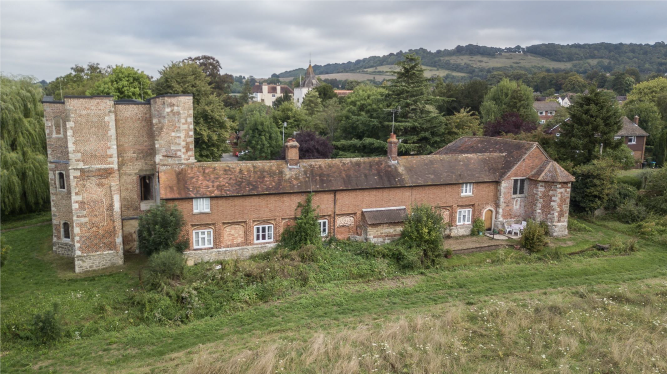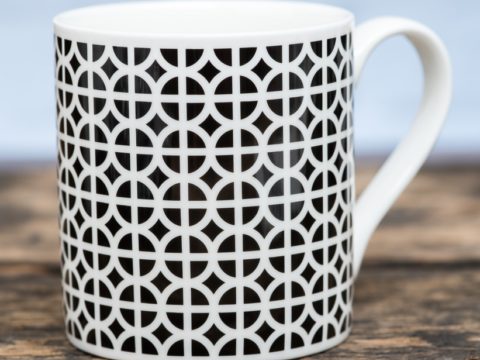Otford Palace
A palace to rival Hampton Court
The Archbishops of Canterbury’s ownership of Otford manor dates back to the ninth century when the land was gifted to Wulfred, an Anglo-Saxon Archbishop of Canterbury, by Offa, King of Mercia. As manorial lords, they had a manor house, with moat and fishponds, on what was a convenient staging post on the London to Canterbury route for Archbishops, and the London to Dover route for royalty.
Around 1515, Archbishop William Warham (c. 1450 – 1532) began a building programme at Otford that created a magnificent palace, larger than its contemporary at Hampton Court, constructed by his rival, Cardinal Wolsey, and one of the largest houses in England. Built of the red brick characteristic of Tudor palaces, it contained two main courtyards, the inner one of which occupied the moated site of the medieval manor house and was accessed via a wooden bridge that connected to the great gallery. The medieval great hall, chapel and state apartments were within this moated site too. The main outer courtyard was rectangular and included a gallery in its west range with 21 adjoining chambers for housing the archbishop’s large household. The palace had splendid formal gardens, substantial fish-ponds and rabbit warrens, along with an extensive deer park, of some 220 acres, for hunting.

Warham and his successor, Archbishop Thomas Cranmer (1489 – 1556), hosted many notable guests at Otford Palace. Erasmus, the distinguished Humanist, and Holbein, the Renaissance painter, were regular visitors and the Papal Legate, Cardinal Campeggio, spent two nights at Otford in July 1518 en-route between Dover and London, where he confirmed Cardinal Wolsey’s status as legate for Pope Leo X.
Royalty also made use of Otford’s convenient location and impressive facilities. Henry VIII visited on a number of occasions, and on two in particular he was accompanied by large entourages. In August 1514, in the process of escorting his sister, Mary, to Dover on her journey to France and marriage with Louis XII, they made an overnight stop at Otford. Henry stayed overnight again in May 1520 with his wife, Katharine of Aragon, on their journey to the Pale of Calais for the Field of Cloth of Gold with a retinue then that ultimately numbered some 5,000 by the time they reached their destination. Henry and Katharine’s daughter, Princess Mary, later Mary I, lived at the palace in 1532/1533, during her parents’ acrimonious divorce. Whilst there, she addressed a letter of business to Thomas Cromwell, requesting a favour for one of her servants.
In 1537, however, Otford Palace came into Crown ownership when Cranmer had to surrender Otford to Henry VIII, along with the episcopal palace at nearby Knole, in return for lands worth a fraction of their value.
In 1543, when her relationship with her father had been rehabilitated, Mary was assigned her own lodgings at Otford Palace. It was here, too, in October 1544 that Henry was reunited with his sixth and last wife, Katherine Parr, following his return from military campaign in France, and they spent more than a week at the palace before travelling back to London.
Nevertheless, despite its grandeur, convenient location and investment by Henry in the palace’s buildings, fishponds, gardens and deer park, Otford’s situation on a low-lying flood plain was a problem and Henry made clear his preference for nearby Knole. Following Henry’s death in 1547 Otford fell rapidly into decline.
The palace was granted to the Archbishopric of Canterbury by Mary I during Cardinal Pole’s brief tenure (1556-58), before reverting to the Crown.
Early in Elizabeth I’s reign Otford was identified as one of the nine progress houses that the Queen would retain and use on a regular basis. However, during her 44 year reign, Elizabeth only visited Otford twice. She made a six day stay in July 1559 and stopped off prior to a six day visit to Knole in July 1573. Elizabeth did not spend any money on Otford but was also reluctant, as with her other properties, to dispose of it. In 1592 Otford passed out of Crown ownership when Elizabeth granted it to Sir Robert Sidney. Sadly, though, the palace continued to deteriorate into a ruinous state.
Today, the palace site of around one hectare covers private and Council-owned land to the south of St Bartholomew’s Church. All that remains from the Tudor period is part of the north range – the north-west corner tower, part of the northern gatehouse and the connecting wall which has been made into a row of small cottages. Whilst the range and tower can only be viewed from the outside, the Otford Heritage Centre in the High Street has information about the history of the palace and a model of what it would have looked like in the sixteenth century.
Sevenoaks District Council has granted a 99 year lease to the Archbishop’s Palace Conservation Trust which has plans to conserve the building and create an interpretation centre that provides material on Otford Palace, the Tudors and the history of the Otford and Darent Valley area.


